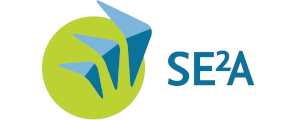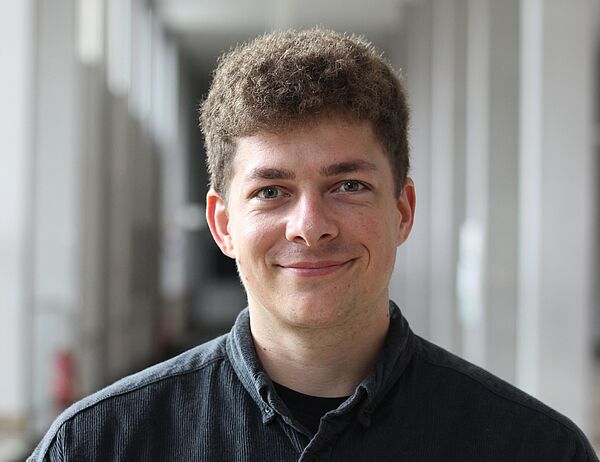
The first CampusXperience took place at TU Braunschweig last weekend, with the SE²A Cluster of Excellence and its institutes present at the Research Airport campus. On 20th June, Yannik Hüpel, a SE²A-PhD and research assistant at the Institute for Acoustics and Dynamics at TU Braunschweig, was one of the science slammers who opened the event CampusXperience in the Audimax that day. He slammed about how we could hear tomorrow’s airplanes today and what wine tasting has to do with it. The following evening, an enthusiastic audience listened to a keynote speech by Prof. Dr. Jens Friedrichs on 'Opportunities and challenges for sustainable flying in the future', which was a discussion about realistic and unrealistic scenarios for sustainable flying from 2025 onwards as seen through the lens of the SE²A Cluster of Excellence, among others
Keynote speech by Prof. Dr. Jens Friedrichs: Opportunities and challenges for sustainable flying in the future
A discussion of realistic and unrealistic scenarios for sustainable flying from 2025 onwards, as seen through the lens of the SE²A Cluster of Excellence.
Prof. Dr. Jens Friedrichs
Institute of Jet Propulsion and Turbomachinery
Spokesperson of the SE²A Cluster of Excellence

Science Slam by Yannik Hüpel: Of wine and aircraft acoustics
How can we hear tomorrow’s aeroplanes today and what does wine tasting have to do with it?
Yannik Hüpel
Institute for Acoustics and Dynamics
SE²A-PhD and Research assistant at the Institute for Acoustics and Dynamics at TU Braunschweig

During the ten fully booked 'expeditions', numerous interested visitors gained insights into aerospace research on Saturday, 21 June 2025. The Institute of Space Systems (IRAS), the Institute of Flight Propulsion and Turbomachinery (IFAS), the Institute of Fluid Mechanics (ISM), and the Institute of Flight Guidance (IFF) all participated.
During the two-hour 'Fascination of Aviation' tour of the Institute of Fluid Mechanics (ISM) and the Institute of Flight Propulsion and Turbomachinery (IFAS), participants learnt a great deal about the scientists' research involving wind tunnels and test rigs. Daniel Kessler and Patrick Brunow from IFAS gave the participants an unusual insight by showing them the inside of the propulsor test rig, for example.
They then unveiled the drone test rig, which is still under construction, to the public for the first time. In the future, drones will be able to be tested here in a wind tunnel and analysed to see how they fly (aerodynamics) and whether their electronics interfere with themselves or other devices and environments (EMC = electromagnetic compatibility). Daniel Kessler explained that the cube of the test stand is like a large microwave. There is even a turntable inside — science explained clearly! This test rig is only one of a handful in Europe and a valuable addition to the Research Airport Campus's unique research infrastructure.
Dr. André Bauknecht from the Institute of Turbomachinery then explained the different types of wind tunnels and how he and his colleagues use them for testing. First, the group visited the MUB (model subsonic tunnel). This ‘atmospheric wind tunnel’ can measure various aerodynamic parameters. These include lift and drag, to name a few. Currently, a wing model is positioned in the wind tunnel. Next, the group moved on to the ice and multiphase wind tunnel, where we can study what happens when air isn't just dry, but also contains water droplets or ice crystals. After switching it on, the participants could see icing on the wing model within seconds. As well as being cold, wind tunnels can also be quite loud, as the visitors discovered.
At the end of the tour, participants were allowed to experiment with a small, mobile wind tunnel themselves. They could use a small wing model attached there to see at what wind speeds and angles the lift would be optimal, and at what point the aircraft would crash, with the participants setting these themselves. The wind tunnel's airflow was demonstrated using a smoke lance. Smoke was introduced into the flow to visualise the streamline. This meant that visitors could not only feel but also see the current.
At the Institute of Space Systems (IRAS), Prof. Dr. Silvestri and her team showed visitors how the future of space travel is being created. Declan Jonckers impressed the audience with a demonstration of multilayer thermal insulation (MLI). Aditya Thakur and Antonio Depardon gave an impressive presentation on how rovers travel across the Martian surface. Tom Linnemann explained the workings of a real rocket thrust chamber on the MOZART mobile rocket test stand. Patrick Plörer showed how satellites move in space in the ELISSA test stand. Daniel Raphael Wacker and Carsten Wiedemann emphasised the importance of space debris disposal and presented various methods. The event concluded with the presentation of a rocket built entirely by ERIG e.V. students.
SE²A would like to thank everyone involved for their commitment. And, of course, we would like to thank our visitors for their curiosity and questions! Find more impressions of the event here
However, the IFAS and ISM were not the only places offering exciting insights. At the Institute of Flight Guidance (IFF), visitors could find out how researchers are addressing the challenge of achieving the political and social climate targets.
Staff members Michael Ritzau-Jost, Andreas Schlerf, Tom Neumann, Renato Lumia and Prof. Dr. Lampert guided groups of interested visitors through four stations. Firstly, participants tested flights in the cockpit simulator themselves, followed by a demonstration of the HELiPOD, which is used to test alternative rotor drives. The HELiPOD is a helicopter-towed probe. Participants then had the opportunity to control manoeuvres in a drone simulation. Finally, there was a presentation on ALADINA (Application of Light-Weight Aircraft for Detecting In-situ Aerosol), an unmanned research aircraft and associated measuring drone. The presentation covered the sensors and their potential applications.
Technische Universität Braunschweig
Cluster of Excellence SE²A –
Sustainable and Energy-Efficient Aviation
Hermann-Blenk-Str. 42
38108 Braunschweig
se2a(at)tu-braunschweig.de
+49 531 391 66661
